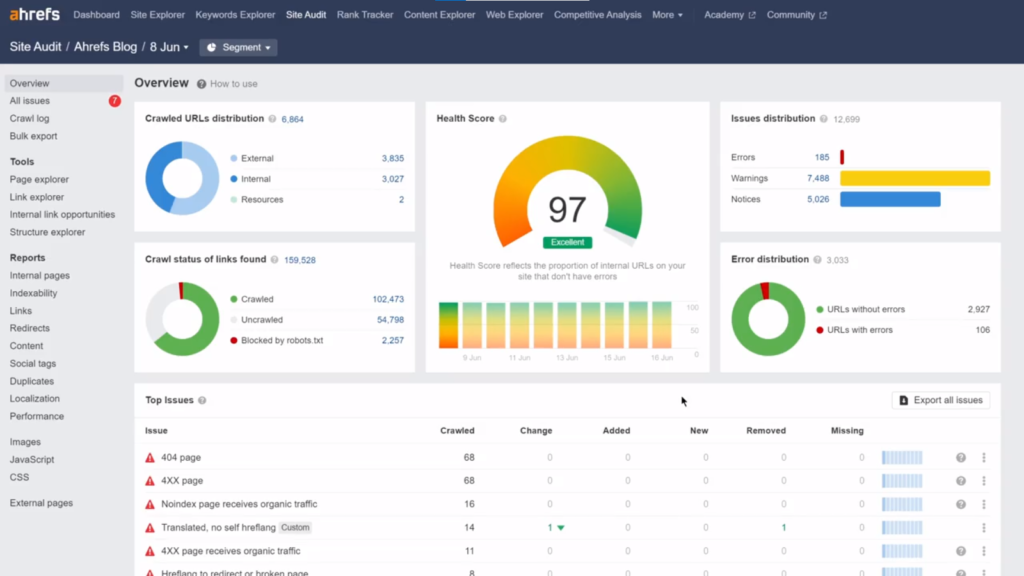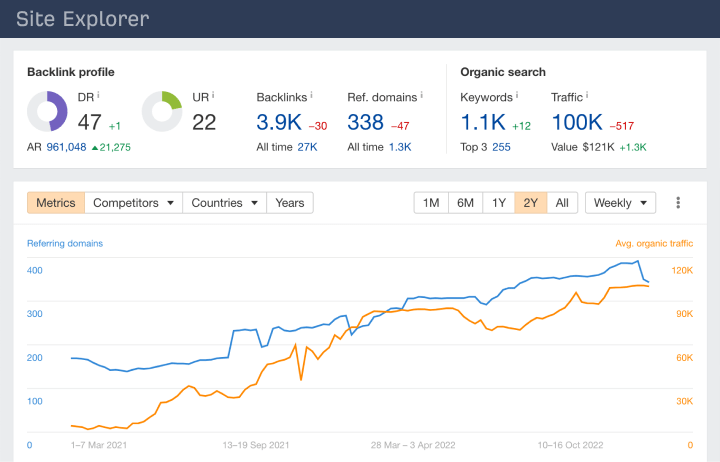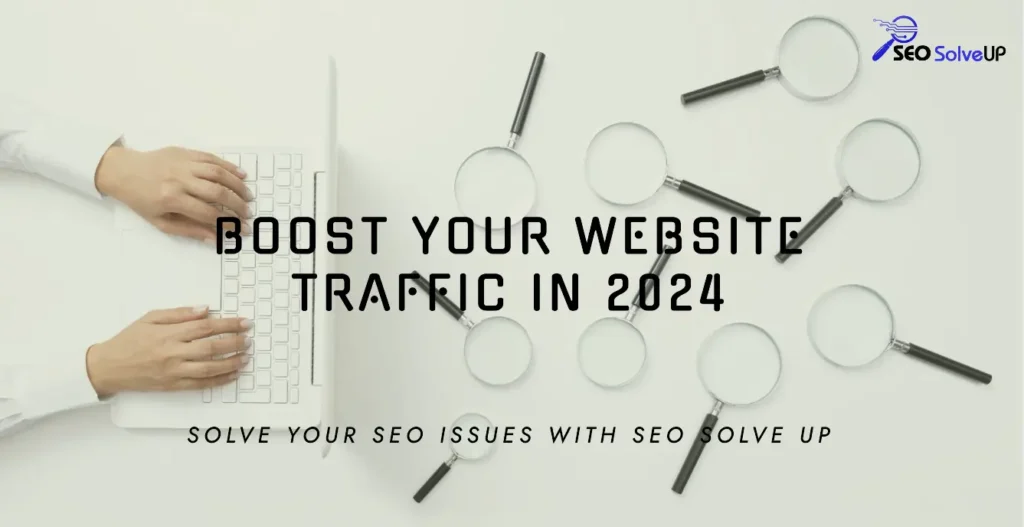Have you ever wondered why your website is not getting enough traffic, leads, or sales, despite having great content and design? Chances are, you have some SEO issues that are hurting your site’s visibility and performance in search engines.
SEO issues are common and can affect any website, regardless of its size, niche, or industry. They can range from technical errors, such as broken links, slow loading speed, or duplicate content, to content-related issues, such as low-quality content, keyword stuffing, or poor optimization. If left unresolved, these issues can negatively impact your site’s ranking, user experience, and conversion rate.
That’s why you need to solve SEO issues as soon as possible and prevent them from happening again in the future. This is where SEO Solve Up comes in. SEO Solve Up is the process of finding and fixing common SEO problems that can hamper your website’s success. In this article, you will learn how to:
- Identify the SEO issues using SEO tools
- Diagnose the SEO issues by categorizing them into technical, content, or off-page
- Implement the SEO solutions by fixing the errors, optimizing the content, and improving the off-page factors
- Prevent SEO issues by monitoring your site’s health and performance, updating your site’s content and design, and following the latest SEO trends and algorithm changes
By following these steps, you will be able to solve SEO issues and boost your website traffic in 2024 and beyond.
Are you ready to solve SEO issues and grow your online business? Then let’s get started!
How to Identify SEO Issues
The first step of SEO Solve Up is to identify the SEO issues that are affecting your website’s performance and ranking. You can’t solve a problem if you don’t know what it is, right? But how do you find out what SEO issues your website has? There are three main ways to do this:
- Use SEO tools to audit your website
- Check your site’s performance and ranking metrics
- Analyze your site’s traffic and user behaviour
Let’s look at each of these methods in more detail.
If You Want these serivces Let’s connect to SEO Solve Up
Use SEO tools to audit your website
One of the easiest and most effective ways to identify SEO issues is to use SEO tools that can scan your website and detect any errors, warnings, or suggestions. There are many SEO tools available online, both free and paid, that can help you with this task. Some of the most popular and reliable ones are:
- Google Search Console: This is a free tool from Google that allows you to monitor and optimize your site’s presence in Google search results. It can help you identify issues such as crawl errors, indexation issues, mobile usability issues, security issues, and more. You can also use it to submit sitemaps, request indexing, and view your site’s performance and ranking data.
- Bing Webmaster Tools: This is a similar tool from Bing that helps you improve your site’s visibility and performance in Bing search results. It can help you identify issues such as crawl errors, indexation issues, mobile friendliness issues, malware issues, and more. You can also use it to submit sitemaps, request indexing, and view your site’s performance and ranking data.
- SEMrush: This is a paid tool that offers a comprehensive suite of features for SEO, content marketing, social media, and PPC. It can help you identify issues such as technical SEO issues, content issues, backlink issues, keyword issues, and more. You can also use it to conduct competitor analysis, keyword research, content optimization, and more.
- Ahrefs: This is another paid tool that specializes in backlink analysis and SEO. It can help you identify issues such as technical SEO issues, content issues, backlink issues, keyword issues, and more. You can also use it to conduct competitor analysis, keyword research, content optimization, and more.
To use these tools, you need to sign up for an account and verify your website ownership. Then, you can run a site audit and get a report that shows you the SEO issues your website has, along with their severity, impact, and possible solutions. You can also export the report as a CSV or PDF file for further analysis.
Here is an example of a site audit report from SEMrush:
!Site audit report from SEMrush

As you can see, the report shows you the total number of issues, the number of errors, warnings, and notices, and the overall site health score. It also shows you the list of issues, their impact, and how to fix them. You can click on each issue to get more details and examples.
Using SEO tools to audit your website is a quick and easy way to identify SEO issues, but it is not enough. You also need to check your site’s performance and ranking metrics and analyze your site’s traffic and user behaviour. These methods will help you understand the impact and the root causes of the SEO issues, and how to prioritize and solve them.
Are You Done? Let’s move forward!
How to Diagnose SEO Issues
Once you’ve identified the SEO issues that your website has, the next step is to diagnose them. This means finding out the causes and the impact of each issue, and how to prioritize and solve them.
To diagnose SEO issues, you need to categorize them into three main types: technical, content, and off-page. Each type of issue has different causes, effects, and solutions. Let’s look at each type in more detail.
“Let’s talk more about resolving your issue with a Free SEO Consultation.
Technical SEO issues
Technical SEO issues are related to how your website is built, structured, and coded. They affect how search engines crawl, index, and render your website, as well as how users access and experience it.
Some common technical SEO issues are:
- Broken links: These are links that lead to non-existent or inaccessible pages, either within your website or to external sources. Broken links can hurt your site’s usability, credibility, and ranking, as they create a poor user experience and signal low quality to search engines.
- Slow loading speed: This is how long it takes for your website or a specific page to load completely. Slow loading speed can negatively affect your site’s user experience, conversion rate, and ranking, as users tend to abandon sites that take too long to load, and search engines favour fast-loading sites.
- Duplicate content: This is when your website has identical or very similar content across multiple pages, either within your website or across different domains. Duplicate content can confuse search engines and users, and dilute your site’s authority and relevance, as they don’t know which page to rank or trust.
- Mobile unfriendliness: This is when your website is not optimized for mobile devices, such as smartphones and tablets. Mobile unfriendliness can harm your site’s user experience, traffic, and ranking, as more and more users browse the web on mobile devices, and search engines prioritize mobile-friendly sites.
To diagnose technical SEO issues, you need to use SEO tools that can scan your website and detect any errors, warnings, or suggestions. You can use the same tools that we mentioned in the previous section, such as Google Search Console, Bing Webmaster Tools, SEMrush, and Ahrefs.
These tools will give you a report that shows you the technical SEO issues your website has, along with their severity, impact, and possible solutions. You can also export the report as a CSV or PDF file for further analysis.
Here is an example of a technical SEO report from Ahrefs:
!Technical SEO report from Ahrefs

As you can see, the report shows you the total number of issues, the number of errors, warnings, and notices, and the overall site health score. It also shows you the list of issues, their impact, and how to fix them. You can click on each issue to get more details and examples.
Content SEO issues
Content SEO issues are related to the quality, quantity, and relevance of the content on your website. They affect how search engines understand, rank, and display your website, as well as how users find, consume, and engage with your content. To avoid these issues, you need to follow a website content checklist that covers the best practices for creating and optimizing your web content.
Some common content SEO issues are:
- Thin content: This is when your website has pages that have little or no value to users or search engines. Thin content can hurt your site’s ranking, traffic, and conversions, as it signals low quality and relevance to search engines, and provides a poor user experience.
- Keyword stuffing: This is when your website has pages that use keywords excessively or unnaturally, either in the content, title, meta tags, or URL. Keyword stuffing can harm your site’s ranking, credibility, and usability, as it signals spam and manipulation to search engines, and creates a bad user experience.
- Missing or poorly written title tags and meta descriptions: These are the elements that appear in the search engine results pages (SERPs) and describe what your page is about. Missing or poorly written title tags and meta descriptions can reduce your site’s click-through rate, traffic, and conversions, as they fail to attract and persuade users to visit your page.
- Content gaps: These are the topics or keywords that your target audience is searching for, but your website does not have content for. Content gaps can limit your site’s reach, visibility, and authority, as you miss out on opportunities to satisfy user intent and rank for relevant queries.
To diagnose content SEO issues, you need to use SEO tools that can analyze your website and identify any problems, opportunities, or suggestions. You can use the same tools that we mentioned in the previous section, such as Google Search Console, Bing Webmaster Tools, SEMrush, and Ahrefs.
These tools will give you a report that shows you the content SEO issues your website has, along with their impact, difficulty, and possible solutions. You can also export the report as a CSV or PDF file for further analysis.
Here is an example of a content SEO report from SEMrush:
!Content SEO report from SEMrush
As you can see, the report shows you the total number of issues, the number of errors, warnings, and notices, and the overall content score. It also shows you the list of issues, their impact, and how to fix them. You can click on each issue to get more details and examples.
Off-page SEO issues
Off-page SEO issues are related to the external factors that influence your website’s reputation, authority, and popularity. They affect how search engines and users perceive, trust, and link to your website, as well as how your website competes with other websites in your niche.
Some common off-page SEO issues are:
- Low-quality backlinks: These are the links that point to your website from other websites that have low authority, relevance, or trustworthiness. Low-quality backlinks can damage your site’s ranking, traffic, and reputation, as they signal low quality and spam to search engines, and create a negative user perception.
- Lack of backlinks: This is when your website has few or no links from other websites, especially from authoritative, relevant, and trustworthy sources. A lack of backlinks can hinder your site’s ranking, visibility, and authority, as they indicate low popularity and relevance to search engines, and create a weak user perception.
- Negative online reviews: These are the reviews that users leave about your website, products, or services on online platforms, such as Google My Business, Yelp, or Trustpilot. Negative online reviews can hurt your site’s ranking, conversions, and reputation, as they signal low quality and satisfaction to search engines and create a bad user impression.
- Poor social media presence: This is when your website has little or no engagement on social media platforms, such as Facebook, Twitter, or Instagram. Poor social media presence can limit your site’s reach, traffic, and awareness, as you miss out on opportunities to connect and communicate with your target audience and potential customers.
To diagnose off-page SEO issues, you need to use SEO tools that can monitor your website and measure its performance, reputation, and popularity. You can use the same tools that we mentioned in the previous section, such as Google Search Console, Bing Webmaster Tools, SEMrush, and Ahrefs.
These tools will give you a report that shows you the off-page SEO issues your website has, along with their impact, difficulty, and possible solutions. You can also export the report as a CSV or PDF file for further analysis.
Here is an example of an off-page SEO report from Ahrefs:
!Off-page SEO report from Ahrefs

As you can see, the report shows you the total number of backlinks, referring domains, organic keywords, and organic traffic that your website has. It also shows you the domain rating, URL rating, and Ahrefs rank of your website, which indicates its authority and popularity. You can also see the distribution of your backlinks by type, platform, language, and country. You can click on each metric to get more details and examples.
You now know how to find or reach them, Let’s move forward in which you will learn how to implement SEO on your website.
How to Implement SEO Solutions
After you’ve identified and diagnosed the SEO issues that your website has, the next step is to implement the SEO solutions. This means fixing the errors, optimizing the content, and improving the off-page factors that affect your site’s performance and ranking.
To implement SEO solutions, you need to follow these general guidelines:
- Fix the technical issues first. Technical SEO issues are the most urgent and impactful ones, as they can prevent search engines and users from accessing and understanding your website. Therefore, you should prioritize fixing them before moving on to content or off-page issues. Use the SEO tools that we mentioned in the previous sections to find and fix technical issues, such as broken links, slow loading speed, duplicate content, and mobile unfriendliness. You can also use other tools, such as Google PageSpeed Insights, Screaming Frog, or Moz Link Explorer, to help you with specific aspects of technical SEO.
- Optimize your content for your target audience and keywords. Content SEO issues are related to how well your website provides relevant, valuable, and engaging information to your audience. They affect how search engines and users perceive and rank your website. Therefore, you should optimize your content for your target audience and keywords, by following these best practices:
- Conduct keyword research to find the best keywords for your niche, industry, and audience. Use tools like Google Keyword Planner, SEMrush, or Ahrefs to find keyword ideas, search volume, difficulty, and intent.
- Create high-quality content that answers your audience’s questions, solves their problems, and satisfies their needs. Use tools like Grammarly, Hemingway, or Wordtune to improve your writing style, grammar, and tone.
- Optimize your content for your target keywords, by using them naturally and strategically throughout your content. Use tools like Yoast SEO, Rank Math, or SEO Writing Assistant to check your keyword density, readability, and SEO score.
- Optimize your content for search engines, by using proper HTML tags, meta tags, headings, images, links, and schema markup. Use tools like Google Rich Results Test, Schema.org, or SEO Minion to check and improve your content’s structure, format, and markup.
- Build and earn high-quality backlinks and citations. Off-page SEO issues are related to how your website is connected and referenced by other websites and online platforms. They affect how search engines and users trust and value your website. Therefore, you should build and earn high-quality backlinks and citations, by following these best practices:
- Create link-worthy content that attracts and deserves links from other authoritative and relevant websites. Use tools like BuzzSumo, AnswerThePublic, or Quora to find popular and trending topics, questions, and keywords in your niche.
- Reach out to other website owners, bloggers, influencers, journalists, and experts in your niche, and pitch them your content, offer them value, and ask them for links. Use tools like Hunter, Mailshake, or Pitchbox to find and contact potential link prospects, and manage your outreach campaigns.
- Leverage social media, online directories, forums, communities, and other platforms to promote your content, increase your exposure, and generate social signals, reviews, and citations. Use tools like Hootsuite, Buffer, or Sprout Social to manage your social media presence, and tools like Yelp, Google My Business, or Tripadvisor to manage your online reputation.
By following these guidelines, you will be able to implement SEO solutions and fix the SEO issues that are affecting your website’s performance and ranking. However, implementing SEO solutions is not a one-time activity, but a continuous process that requires regular monitoring, testing, and updating.
In the next section, we will show you how to prevent SEO issues from happening again in the future.
How to Prevent SEO Issues
The final step of SEO Solve Up is to prevent SEO issues from happening again in the future. This means keeping your website healthy, updated, and optimized, and following the latest SEO trends and algorithm changes.
To prevent SEO issues, you need to follow these general guidelines:
- Monitor your site’s health and performance regularly. You should always keep an eye on your site’s health and performance, and check for any errors, warnings, or suggestions that might affect your site’s SEO. You can use the same SEO tools that we mentioned in the previous sections, such as Google Search Console, Bing Webmaster Tools, SEMrush, and Ahrefs, to monitor your site’s health and performance. You can also set up alerts and notifications to get notified of any issues or changes that might occur.
- Update your site’s content and design according to best practices. You should always keep your site’s content and design fresh, relevant, and engaging, and follow the best practices for content creation and optimization. You can use tools like Google Analytics, Hotjar, or Crazy Egg to measure and improve your site’s content and design, and tools like WordPress, Wix, or Squarespace to manage and update your site’s content and design.
- Follow the latest SEO trends and algorithm changes. You should always keep up with the latest SEO trends and algorithm changes, and adapt your site’s SEO strategy accordingly. You can use tools like Google Trends, MozCast, or Search Engine Land to stay updated on the latest SEO trends and algorithm changes, and tools like Google Search Central Blog, SEMrush Blog, or Ahrefs Blog to learn and apply the best SEO practices and tips.
By following these guidelines, you will be able to prevent SEO issues from happening again in the future and maintain your site’s SEO health and performance. Remember, SEO is not a one-time activity, but a continuous process that requires constant monitoring, testing, and updating. The more you prevent SEO issues, the more you will save time, money, and effort, and the more you will grow your online business.
That’s it! You have completed the SEO Solve Up process and learned how to identify, diagnose, implement, and prevent SEO issues. We hope you found this article useful and informative. If you did, please share it with your friends and colleagues who might benefit from it. And don’t forget to leave a comment below and let us know what you think. We would love to hear from you and answer any questions you might have.
You have reached the end of this article and learned how to solve SEO issues and boost your website traffic in 2024. Congratulations! You have just completed the SEO Solve Up process and gained valuable knowledge and skills that will help you grow your online business.
Conclusion
SEO issues are common and can affect any website, regardless of its size, niche, or industry. They can range from technical errors, such as broken links, slow loading speed, or duplicate content, to content-related issues, such as low-quality content, keyword stuffing, or poor optimization. If left unresolved, these issues can negatively impact your site’s ranking, user experience, and conversion rate.
That’s why you need to solve SEO issues as soon as possible and prevent them from happening again in the future. This is where SEO Solve Up comes in. SEO Solve Up is the process of finding and fixing common SEO problems that can hamper your website’s success. It involves four steps:
- Identify the SEO issues using SEO tools
- Diagnose the SEO issues by categorizing them into technical, content, or off-page
- Implement the SEO solutions by fixing the errors, optimizing the content, and improving the off-page factors
- Prevent SEO issues by monitoring your site’s health and performance, updating your site’s content and design, and following the latest SEO trends and algorithm changes
By following these steps, you will be able to solve SEO issues and improve your site’s visibility, user experience, and conversion rate. SEO Solve Up is not a one-time activity, but a continuous process that requires constant monitoring, testing, and updating. The more you solve SEO issues, the more you will learn and improve your SEO skills and strategies.
Remember, SEO is not a sprint, but a marathon. It takes time, effort, and patience to achieve the best results. But with SEO Solve Up, you can make the journey easier and more rewarding.
Now that you know how to solve SEO issues, it’s time to take action and apply what you learned. Start by auditing your website and identifying the SEO issues you need to solve. Then, follow the steps we outlined in this article to diagnose and implement the best solutions. Finally, keep an eye on your site’s health and performance and prevent SEO issues from happening again.
If you need any help or guidance along the way, feel free to contact us. We are a team of SEO experts who can help you solve SEO issues and boost your website traffic in 2024. We offer a free SEO audit and consultation for new clients. Just fill out this form and we will get back to you as soon as possible.
Thank you for reading this article. We hope you found it useful and informative. If you did, please share it with your friends and colleagues who might benefit from it. And don’t forget to leave a comment below and let us know what you think. We would love to hear from you and answer any questions you might have.
You Might Happy to learn More With Us: SEO Solve Up


